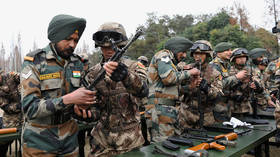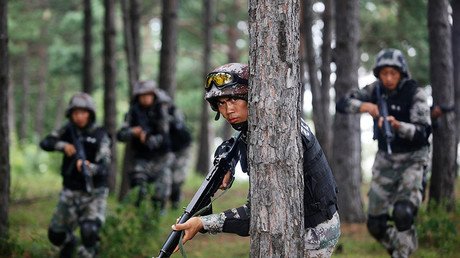The devil you know: Old foes India & China strengthen ties as America proves too unreliable

China and India have had a rocky relationship for years and are continuing to find areas of dispute. However, the two countries have managed to end the year on an amicable high-note, proving that rival nations can cooperate.
Together, China and India account for just under 3 billion of the world’s total population. The decisions that the leaders of these two countries make is therefore relevant for approximately a third of the global population. Whether or not these two regional players are on a path to peace or war is something the western mainstream media should pay its undivided attention to.
While outrageously underreported in the corporate media, India and China experienced a brief skirmish on the Indo-Tibetan border in August last year. Video footage of the skirmishes shows soldiers kicking, punching and throwing stones at each other on the border, which appeared to symbolize a potential escalation between the two Asian powers. The two nations maintain a tense border dispute with hundreds of soldiers stationed just meters apart.
India has also been rattled by China’s overt support and rising participation in Pakistan. India remains unnerved by the $60 billion China-Pakistan Economic Corridor (CPEC), part of China’s Silk Road Project. Reports have also emerged that China has been considering establishing its own naval bases in Pakistan, even though both Pakistan and China have denied such a claim.
China has only one overseas military base, currently in Djibouti in the Horn of Africa. In other words, China’s only overseas military base puts China’s logistical military hubs in the Indian ocean, a constant source of tension for India.
READ MORE: America’s imperial hubris is pushing Pakistan into the arms of Russia & China
However, despite this, no such escalation has appeared to eventuate since the skirmishes in August. In fact, China and India have both taken steps to reduce tensions and may have found a middle path to pursue their conflicting interests. As explained further below, these conflicting interests are not to be taken lightly.
Also on rt.com Awakening a sleeping lion: The US-China Cold War is upon usJust recently, Chinese Foreign Minister Wang Yi took a four-day visit to India to meet high-level Indian officials, including India’s External Affairs Minister Sushma Swaraj. It should be noted that India is China’s largest trading partner, with a trade deficit in favor of China by about $63 billion during 2017-2018.
Altogether, Chinese President Xi Jinping and India’s Prime Minister Narendra Modi have met four times this year alone; and India’s defense minister Nirmala Sitharaman and her Chinese counterpart, Wei Fenghe, have also met three times this year. During these meetings, China has agreed to some concessions, including an agreement to increase its imports of Indian rice, sugar, rapeseed oil and pharmaceuticals.
It is also worth noting that China and India also just completed a joint anti-terrorism military exercise in the Chengdu area of China.
Furthermore, there are some suggestions that China and India may begin working closer together on the issue of Afghanistan as well. Given the Trump administration’s surprise announcement that it will withdraw thousands of troops from the war-torn country, this partnership between China and India may become a distinct possibility.
This is not to say that India does not maintain its wariness of China’s expanding influence in the region.
According to a recent paper entitled “From Denial to Punishment: The Security Dilemma and Changes in India’s Military Strategy Towards China” in Asian Security by Anit Mukherjee and Yogesh Joshi the power imbalance between India and China is no longer manageable. China has rapidly developed its infrastructure, modernized its military and taken a more aggressive stance at the border (as seen in the skirmishes last year), leading India to adopt some strategies of its own. The result is that India will embrace a more active and offensive posture, as opposed to a defensive one.
At the beginning of December, Indian media reported that India was taking steps to counter China’s “strategic footprint” in the Indian Ocean. Specifically, it has approved the construction of 56 new warships and six submarines for its navy over the next decade. One of the submarines will reportedly be from Project-75I, a $US12 billion initiative to “acquire advanced subs equipped with air-independent-propulsion systems that allow non-nuclear subs to operate without atmospheric oxygen, replacing or augmenting diesel-electric systems,” according to Business Insider.
All in all, Delhi’s strategy is to have 200 ships and 500 aircraft by the year 2050. Currently, India’s navy has 40 warships and 220 aircraft, with 32 warships already under construction. At any time, China reportedly has at least six to eight Chinese navy ships in the Indian Ocean Region.
In November, India announced its first domestically built nuclear-powered missile submarine had completed its first deterrence patrol. The announcement appeared to confirm that India had the ability to fire nuclear weapons from land, air and from sea.
It is no secret that India’s strategy is to counter China in the region. According to Admiral Sunil Lanba, India’s navy chief, India has “overwhelming superiority over Pakistan in all domains at sea. In the case of China, with the forces it currently brings to bear in the IOR [Indian Ocean Region], the balance of power is in our [India’s] favor.”
India is also taking part in negotiations to build a naval base in the Seychelles, which is also in the Indian Ocean. India’s navy is conducting patrols with the Maldives, an island nation which could become the scene of a global battlefield as China, India, and the Gulf Arab states all fight for influence. Lanba is of the opinion that the government in the Maldives currently favors India over China. Conversely, former Maldivian President Mohamed Nasheed recently warned that its monumental debt to China put his country at risk of a “land grab.” China remains the biggest investor in the Maldives. India, for its part, has offered to pull the country away from China’s influence by offering to provide loans to help repay its debts to China.
India apparently views China’s strategy in Pakistan, Sri Lanka, and the Maldives as a strategy of “encirclement” due to their proximity to the Indian Ocean. It is for this reason that India is further keeping a close eye on Kenya as it allegedly falls victim to China’s supposed debt trap strategy – Kenya being another of India’s traditional and longstanding partners in Africa. According to India’s Economic Times, Kenya could lose the Mombasa port to China if Kenya Railways Corporation defaults in its payments to the Exim Bank of China, (currently at $2.2 billion debt owing). It is also worth mentioning that India was also concerned that China was looking to build a military port in the Maldives, as well.
Furthermore, just yesterday reports also emerged that India has opened up a road-rail bridge in the northeastern state of Assam, again with a focus on bolstering its defenses against China. The project took almost two decades and $800 million for it to be completed. Allegedly, the bridge will allow the Indian military to speedily deploy its forces to Arunachal Pradesh, on the border of China, and has also been designed to hold the weight of India’s heaviest 60-ton tanks and accommodate India’s fighter jets.
India may have some other tricks up its sleeve in its bid to confront China’s expanding role in the region. According to an OECD report, predictions are that China’s global output will reach its peak in 2030. Conversely, India is outpacing China in terms of economic growth. According to the Asia Times, between 2006 and 2016, India lifted more than 270 million people out of poverty and if this rate continues, it will have eliminated poverty by the year 2030. By comparison, China has already lifted some 700 million people out of poverty, but will still have to deal with the issue of its slowdown of economic growth compared to India’s accelerated economic growth rate of 8 percent.
In other words, in the years to come, India and China will continue to have monumental modes of disagreement as long as they continue to exist on each other’s borders and continue to bear the same desire for regional influence. However, it would appear that the two nations have taken steps to address their disputes and find ways in which to cool the otherwise volatile relationship down, such as the suggested cooperation on places like Afghanistan.
Also on rt.com China to mark economic miracle that pulled 700 million people out of povertyThe other wildcard variable to take into account when analyzing what 2019 could potentially have in store for Sino-Indian relations is Trump’s trade war with China, which could put India at an even greater advantage over China.
Yet at the same time, India, much like the rest of the world, is beginning to learn that the United States is no longer the reliable partner that many countries thought it once was, and that it cannot rely on Washington to mitigate its concerns against rivals such as China.
Like this story? Share it with a friend!
The statements, views and opinions expressed in this column are solely those of the author and do not necessarily represent those of RT.
















